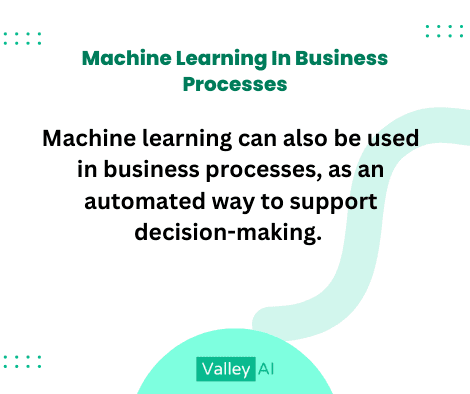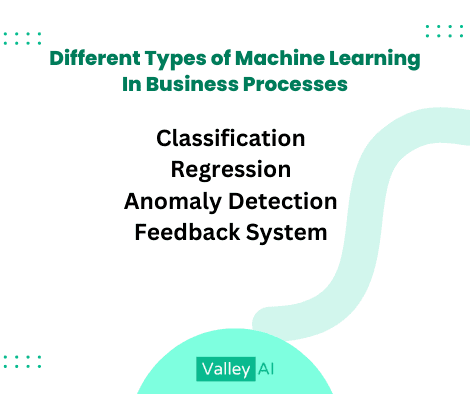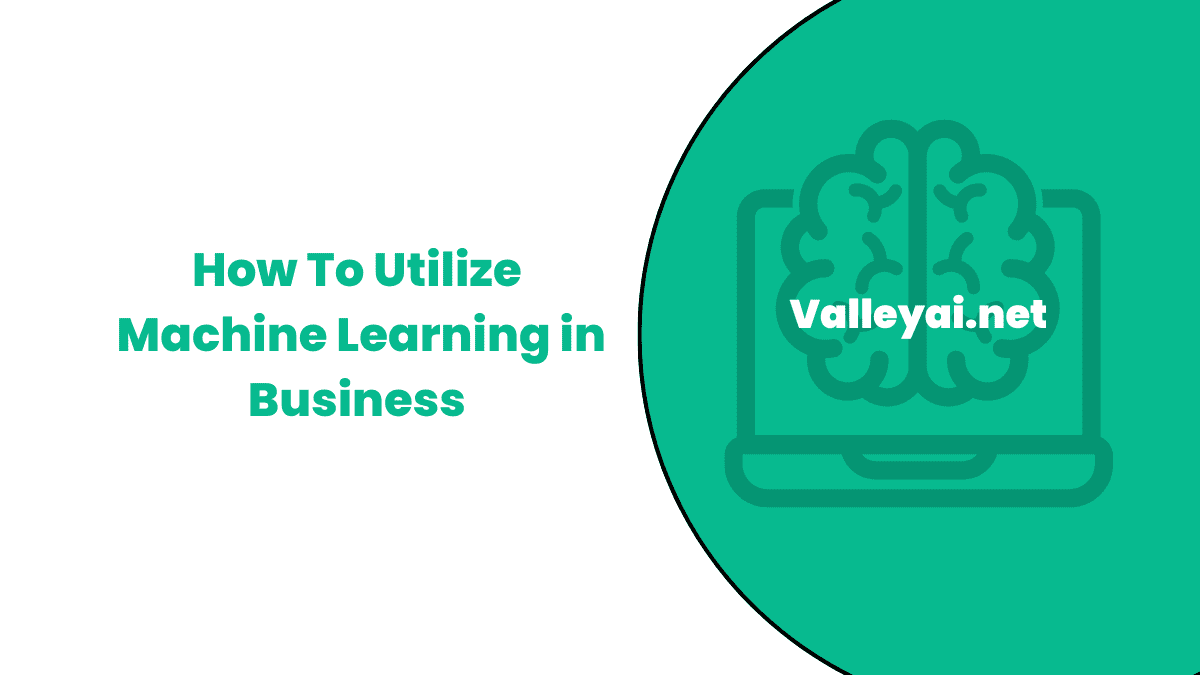These days machine learning in business processes is very popular. We will see the use case of ml automation for business processes and digital transformation.
Since the emergence of big data, businesses have been struggling to find ways to extract value from their data and processes. This is especially true for smaller, millennial-focused companies with limited resources. With a limited team and resources, small, independent companies are at a disadvantage when it comes to using technology effectively.
By taking advantage of this powerful toolset, companies can cut down on costs while improving their business decisions and performance overall.
Even the largest organizations need business processes that are flexible enough to account for changes as they occur. This article explains how you can utilize machine learning (ML) and artificial intelligence (AI) for business processes to boost profits.: what it is, how you can use it, and who should adopt it first.
What is Machine Learning?
Machine learning is a branch of artificial intelligence that builds algorithms to automate certain decision-making processes and tasks to allow computers to learn and improve by themselves. It is a subset of data science and is closely related to statistics and data analysis.
What is Machine Learning In Business Processes?

Machine learning can also be used in business processes, as an automated way to support decision-making. This process can be used for a variety of tasks, identifying trends over time, including predicting future outcomes based on past behavior patterns, improving customer service, or making informed decisions about product design.
ML can also be used in business processes to automate repetitive tasks based on data collected from customers or other sources. It can be used to automatically detect fraud or improve email marketing.
There are cases when an organization may want to focus on specific use cases, like governance, chatbot, logistics, invoices, detect anomalies, and contracts, and this can lead to a lot of your resources being put towards the same area. AI can help automate these business operations so you don’t have to hire for manual interaction.
Different Types of Machine Learning In Business Processes

Let’s see the different types of machine learning in business processes and understand how they work in this field.
Classification
Classification is when the ml model learns to categorize new data into one of a set of categories (also known as a schema). For example, you can use classification to recognize whether a customer is a male, female, or another gender.
Regression
Regression is when the model learns to predict new data’s category. For example, you can use regression to predict the weight of a new customer.
Anomaly Detection
Anomaly detection is when the model learns to predict that a certain type of event is about to take place. For example, you can use anomaly detection to predict that a customer is about to double their order.
Feedback System
Feedback systems are when the ml algorithm is fed with data and trained to provide feedback. For example, you can use feedback systems to evaluate the performance of salespeople or to predict customer behavior for marketing campaigns.
How to Use Machine Learning for Business Processes?
There are many different ways you can use machine learning for business processes.
- You can use machine learning as a tool to automate existing business processes. For example, you may use a model to automatically process customer orders or to optimize processes in the sales team’s workflow.
- You can also use machine learning to create completely new business processes. For example, you might use a model to optimize your customer care process or to manage your product development process.
- You can use machine learning to create hybrid models that encompass both automated and human-led processes. For example, a company may use machine learning to automate some processes and to create hybrid models that involve human decision-making.
Which Organizations Should Adopt Machine Learning for Business Processes?
Businesses can reap the benefits of machine learning in different ways. It depends on a variety of factors including the specific business process in question, the size and scope of the organization, and the available resources.
As such, any organization that is looking to improve its efficiency and productivity should seriously consider adopting machine learning for business processes. However, in general, machine learning can be a valuable tool for businesses of all types and sizes.
Ultimately, the decision of whether or not to adopt machine learning for business processes should be based on a careful evaluation of the potential benefits and risks.
Advantages of Using ML in Business Processes
Automation: Automating decision-making processes allows people to focus on new initiatives, or on more creative tasks.
Enhanced Decision Quality: Automated decision-making systems can ultimately collect more data, provide more insights, and make better decisions.
Reduced Cost: Operational costs can be reduced through the use of machine learning for business processes.
Reduced Risks: Decision-making processes can be automated to reduce risks while allowing for the detection of new types of events.
More Flexible: Business processes can be made more flexible by leveraging machine learning. This allows processes to change with circumstances, and adapt over time.
More Robust: Machine learning can help to make processes more robust, and less likely to be disrupted by external factors.
Higher Accuracy: Predictions made by machine learning are more likely to be correct than human decision-makers.
Disadvantages of Using ML in Business Processes
Lack of Data: It can be difficult to collect the data necessary to train models for a business process. If the data is missing, it may result in inaccurate predictions or decreased model accuracy over time.
Higher Cost: The initial cost of using machine learning for business processes is higher than that of using existing data-driven methods.
Unclear Value: Predictions and insights made by machine learning systems may not always be clear to business teams unless they are explained in detail.
Mixed Results: Predictions made by a model are not always clear-cut, and may not always be the best choice. Business teams may need to make the final decision.
Limitations of Machine Learning for Business Processes
As with any tool, machine learning has limitations that must be taken into account. First, although it can be very helpful for automating processes, it cannot replace the need for human decision-making. As such, it can be useful for supporting decision-making, rather than supplanting it.
Secondly, models built by machine learning can become less accurate over time. This means that, in addition, they may need to be updated with new data to ensure that they continue to make accurate predictions.
Machine learning has many advantages for businesses, but there are also some limitations. If you are interested in using machine learning for business processes, understand the advantages and disadvantages so you can decide whether or not it’s right for your organization.
Conclusion
Organizations can make better progress if their initiatives were based on the same natural language processing (NLP) technology, allowing them to save time and resources in future developments. NLP inputs data into a neural network—a type of machine-learning model that works similarly to the brain—which then does the data processing and produces results.
Machine learning is a powerful tool that can help organizations boost their business processes. By leveraging existing machine learning models, or creating entirely new ones, businesses have the potential to boost revenue, improve customer experiences, and reduce operational costs.
However, like other tools and techniques, machine learning comes with its own set of ml techniques and limitations. If you’re interested in automating your business processes, it’s worth it to explore these issues and think about how you’ll overcome them so that your business can reap the benefits.
It may take some trial and error while implementing an algorithm into your business process, but with the right tools in place, it should make everything run more efficiently and effortlessly!
FAQs on How To Utilize Machine Learning For Business Processes.
A lot of questions were asked about the best way of machine learning in business processes. I covered the questions that the article gives the appropriate answer of these questions.
How can machine learning be used in business?
Machine learning can be used in business to improve various functions, such as detecting and preventing fraud, and spam emails, automating customer interactions, or improving decision-making processes. By using machine learning algorithms that are specifically designed for businesses, companies can speed up the process of making decisions and enhancing their performance.
Why is machine learning so important for businesses?
Machine learning is quickly becoming one of the most important technologies for businesses because it allows companies to process and analyzes data more. With machine learning, businesses are able to identify patterns in data that they would otherwise not be able to see. This can help with a variety of tasks, including marketing planning, customer retention/acquisition strategies, and product development.
How does machine learning improve business processes?
Machine learning is a technology that can improve business processes by automating the analysis of data. This allows businesses to make more informed decisions, faster and with less guesswork. In fact, it has been estimated that machine learning can save organizations up to 90% in time and money when compared to traditional decision-making methods.
How do I implement the algorithm into my business process so that I can start using it immediately?
It can be difficult to implement an algorithm into your business process, but it is essential if you want to improve your productivity and efficiency. One way to start is by creating a task list that will map out all of the tasks that need to be completed in order for your business to operate smoothly. Next, design a system where each task can easily be tracked and assigned a due date or time stamp. The approach aims to reduce analytics development and time. This will help you stay on track and minimize errors throughout the workflows. (including data scientists and data engineers)
Read additional resources on How Top Companies Use Machine Learning.
Admin
My name is Kaleem and i am a computer science graduate with 5+ years of experience in AI tools, tech, and web innovation. I founded ValleyAI.net to simplify AI, internet, and computer topics while curating high-quality tools from leading innovators. My clear, hands-on content is trusted by 5K+ monthly readers worldwide.

